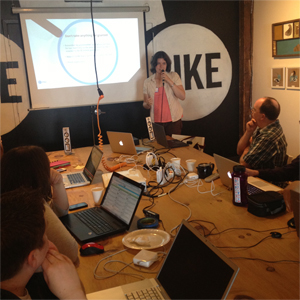
This past weekend was the National Day of Civic Hacking. While for many of us, hacking brings up ominous images of security systems being overridden and important data being stolen, a hackathon is quite the opposite. During a hackathon, a number of techie people get together to solve problems. When you have engineers, programmers, user-interface designers and coders all in the same room, great new programs and applications can quickly take shape. The hackathons happening around the country this past weekend were focused on creating social good and promoting civic engagement.
The Vermont Hackathon, organized by Code for BTV, was focused on issues specific to Vermont, including creating a model of Lake Champlain in Minecraft to engage school-aged children, and creating three websites for local nonprofits.
While all of these developments are very exciting, and have the potential to create real social change, it is important to remember those for whom digital tools are not obvious. I was reminded of this at our recent iConnect workshop. While there, I heard from librarians, adult educators, and employees of the Vermont Department of Labor, all of whom had stories about how hard it was for digital non-natives to adapt to a world in which the internet is increasingly essential. In fact, Jennie Martin, of Central Vermont Adult Basic Education, went so far as to say that in today’s world, “we consider computer literacy a basic skill along with reading, writing and math.”
This makes it particularly hard for individuals who have been surviving for years without a computer, to suddenly find that they have to use one to apply for a new job, to fill out their taxes, or to apply for unemployment benefits.
As a digital native myself, I find that it is easy to forget or to discount those for whom the internet or even a computer or mobile device is not intuitive, but a recent study by the Pew Research Center found that one out of every five adults in the country does not use the internet. Even though the state is hoping to have broadband access to every home in Vermont by the end of 2013, once that access is there, people will still need to learn how to use it.
So, for every great new application or website that is built, we are potentially ignoring 20% of the population. What can we do to address that?
For one thing, as digital natives, it is important to not take our design, layout or projects for granted. In creating the application form for the services provided by the Vermont Digital Economy Project, we made an online form, but also mailed physical copies of the application to town clerks across the state. The majority of applications that we received back were either handwritten and mailed to us or scanned and emailed to us. Had we offered only the online option, we would have excluded most of the people who we were trying to help with our project!
The same is true for all aspects of improving civic engagement. It is important to think about how a project can connect with people offline as well as online. Is there a printable version for people who do not feel comfortable around computers? How easy is the user interface to navigate? Do the buttons look like buttons? Can a respondent filling out an online form take as much time as he or she needs to finish it, or does it time out? Taking all of these consideratons into account when designing and implementing helpful technology is important. We don’t want to leave behind 20% of our population!
I presented on this topic at the Code for BTV event. Below is the slideshow I used. You can also find many more important and instructive tools and information on working with internet beginners in the e-Vermont toolkit.
